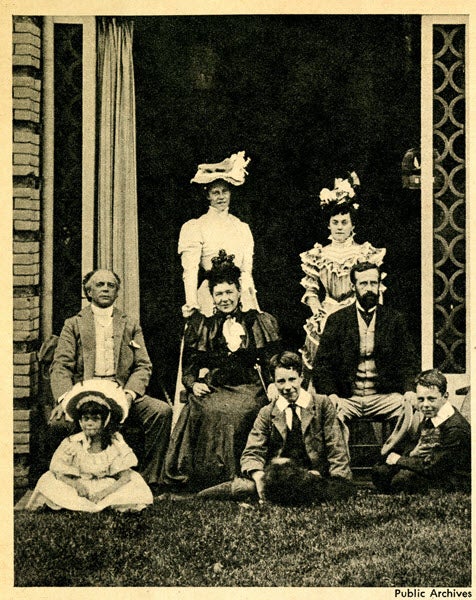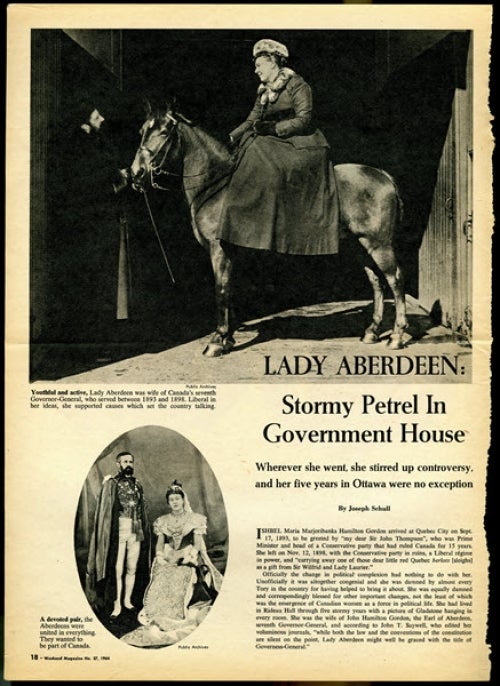Dana Porter Library, first floor
University of Waterloo Library
Waterloo, Ontario N2L 3G1
519-888-4567 x42619 or x42445
Lady Aberdeen
Ishbel Hamilton-Gordon, wife of Lord Aberdeen, Lord-Lieutenant of Ireland, was (and still is) known to be a great humanitarian and philanthropist. In the United Kingdom (UK), Lady Aberdeen had been president of the Women’s Liberal Foundation, an organization that was part of the Liberal Party in the UK and promoted women’s suffrage (which you can learn more about in our Suffragette postcard collection and from our rare books). She also founded the Onward and Upward Association which sought to improve the education and lives of servant girls across the UK. “She founded, inspired, or supported such societies as the National Home Reading Union, the League For The Provision of Seats For Shop Assistants, the Parents’ National Education Union, the Homes for Working Girls, the Mission to Costermongers[,] and half a dozen others. She had been seen, to the horror of her acquaintances, parading the Strand by night urging prostitutes to come in for a cup of tea at her Rescue Mission” (Schull 19, “Lady Aberdeen: Stormy Petrel in Government House” (WA 18, file 3)).
 In 1893, Lord Aberdeen became the Governor General of Canada, prompting the couple to move from the UK. The Aberdeens arrived in Quebec with the mindset of becoming a part of the country and its society. Within the first year, they had not only improved their knowledge of French, but they had also travelled all across Canada. In British Columbia, Lady Aberdeen had catalyzed the formation of the Local Council of Women in Victoria. Here, in 1897, she founded the Victorian Order of Nurses as a gift from the National Council of Women for the 60th jubilee of Queen Victoria’s reign. Ishbel also became heavily involved in politics, making new friends, such as Wilfrid Laurier (as seen in the picture above), whom she agreed with in liberal policies. She was not one to hold her tongue about the issues important to her, giving her an interesting reputation in Canadian politics, as can be seen on the first page of an article written in 1964 (images below). In fact, she was the first woman to speak in the Senate Chamber. In 1897, the same year that the Aberdeens finally departed Canada, Queen’s University had given an honorary degree to Ishbel, the first woman in Canada to receive one. Interestingly, she is also known for having introduced to Canada the golden retriever, a breed allegedly developed by her father Lord Tweedmouth.
In 1893, Lord Aberdeen became the Governor General of Canada, prompting the couple to move from the UK. The Aberdeens arrived in Quebec with the mindset of becoming a part of the country and its society. Within the first year, they had not only improved their knowledge of French, but they had also travelled all across Canada. In British Columbia, Lady Aberdeen had catalyzed the formation of the Local Council of Women in Victoria. Here, in 1897, she founded the Victorian Order of Nurses as a gift from the National Council of Women for the 60th jubilee of Queen Victoria’s reign. Ishbel also became heavily involved in politics, making new friends, such as Wilfrid Laurier (as seen in the picture above), whom she agreed with in liberal policies. She was not one to hold her tongue about the issues important to her, giving her an interesting reputation in Canadian politics, as can be seen on the first page of an article written in 1964 (images below). In fact, she was the first woman to speak in the Senate Chamber. In 1897, the same year that the Aberdeens finally departed Canada, Queen’s University had given an honorary degree to Ishbel, the first woman in Canada to receive one. Interestingly, she is also known for having introduced to Canada the golden retriever, a breed allegedly developed by her father Lord Tweedmouth.






